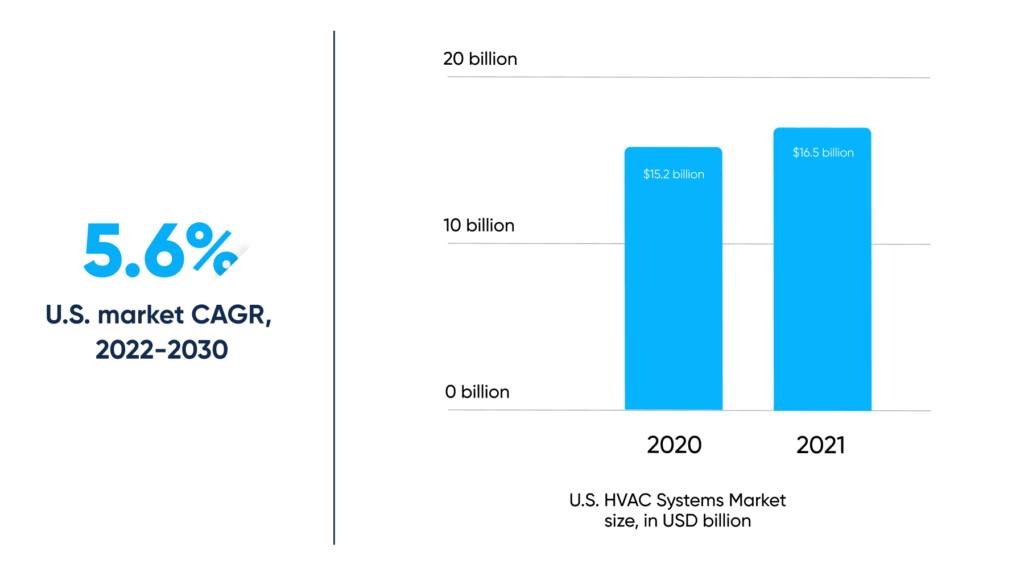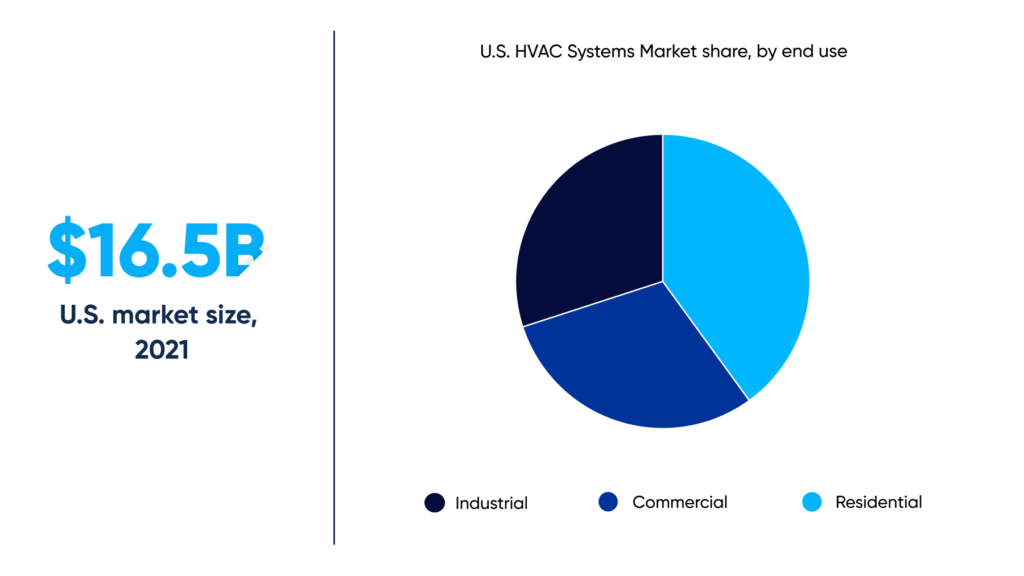How we can make HVAC systems more sustainable

HVAC systems are solutions that regulate and transfer air currents through buildings, from residential (apartments, houses) and commercial (shops, restaurants, office buildings) to industrial (plants, warehouses). These solutions are essential for maintaining thermal comfort and indoor air quality.
HVAC systems, despite being extremely useful, are among prime contributors to looming environmental issues. We can’t expect people to give up on air conditioning, but instead, we can design solutions that incorporate innovative technology to fight climate change.
Market size
As stated by Research and Markets:
- In 2019, the US HVAC market has generated $25,625.8 million
- By 2030, the US HVAC industry is predicted to reach $35,714.5 million
As reported by Grand View Research:
- The US HVAC market was valued at over $16.5 billion in 2021
- The demand for commercial HVAC solutions is anticipated to witness the fastest growth rate of more than 6.00% from 2022 to 2030

Market share
The greatest consumption share is falling on the residential sector, since traditionally, HVAC systems are being mostly utilized by homeowners, in particular in flats, single- and multi-family houses, as well as condominiums. A large consumption share is falling on the commercial sector, with the rapidly expanding construction domain actively erecting malls, hotels, office buildings, and other commercial buildings that require HVAC systems.
HVAC systems are also being implemented in the industrial sector, in particular in productions and warehouses. But speaking about tendencies, HVAC solutions in the industrial domain are expected to experience a sluggish growth rate as upgrades and replacements are conducted rather seldom.

HVAC systems directly impacting climate change
With changing weather conditions, HVAC systems are becoming more and more popular among homeowners. To date, they are being utilized in almost every home.
But still, despite being deeply integrated into our daily lives, HVAC systems are causing some serious problems. More precisely, such solutions are increasing energy waste and emissions, thus contributing to pressing environmental issues.
Energy consumption
HVAC products, if not properly designed, installed, calibrated, and operated, can impact energy consumption. Talking about business operation, high consumption might cause increased expenses, reduced efficiency, customer dissatisfaction, and respectively low competitiveness.
The reasons for increased energy consumption are typically:
- Inefficient equipment
HVAC solutions that are poorly designed, installed, calibrated, or operated, are vulnerable to malfunction (temperature and humidity fluctuation, clogged filters and coils, motor failure, refrigerant leaks, and more), which increase energy waste.
- Manual operation
HVAC solutions that lack smart controls work steadily regardless occupancy, indoor or outdoor temperature, which increases energy waste.
Greenhouse emissions
HVAC products, in particular obsolete and malfunctioning equipment, can impact environmental conditions. Speaking about business outcomes, increased emissions might cause compliance burdens, limited potential, reputational and financial losses, and more.
The reasons for increased greenhouse emissions are typically:
- Fossil fuels
Furnaces, boilers, backup generators, absorption chillers, and other utilized equipment are using fossil fuels, which release greenhouse gasses when burned.
- System leaks
Inaccurate inspection and operation might cause ductwork and refrigerant leaks, which release chemical waste directly into the atmosphere.
Making your HVAC system more sustainable
If modernized to minimize energy consumption and emissions, HVAC systems can become more sustainable. Approached appropriately, innovative technology reduces expenses, increases efficiency, and accelerates consumer comfort.
But putting theory aside, here are some ways to improve HVAC sustainability by providing software or light hybrid solutions (without replacing current hardware):
- Smart controls
- Energy analysis and reporting
- Demand response
- Predictive maintenance
From building smart controls to applying predictive maintenance, HVAC systems require accurate data analysis. Computational technology can accelerate data collection and processing, accordingly providing valuable insights and improving overall performance.
There are several ways to manage HVAC data in real-time:
- Building Automation Systems (BAS)
BAS solutions are used to monitor and control HVAC systems and other household systems (lighting, security). Such software might help gather data, identify trends and issues, provide alerts on anomalies, and respectively optimize overall energy consumption.
- Internet of Things (IoT)
IoT solutions are usually integrated into HVAC systems to collect control parameters (temperature, humidity). Such software can be easily integrated with other household systems to provide better analysis and control.
- Edge computing
Edge computing means processing gathered data at the network edge, rather than at the centralized server. Speaking about HVAC modernization, edge computing can help instantly analyze collected data in real-time, thus improving response times and latency.
- Machine learning
ML algorithms can process sensor data to identify those patterns and anomalies that indicate potential issues. Speaking about HVAC improvement, ML algorithms can help continuously analyze collected data in real-time, thus minimizing environmental damage and preventing sudden breakdowns.
Data storage
When selecting the database for storing and processing collected data, there are multiple factors to consider. These include business needs, project requirements, storage capacity, scalability, flexibility, and performance.
Speaking about HVAC systems, the databases available are:
- Relational databases (MySQL, PostgreSQL, and Oracle)
These databases are the most useful when dealing with data with clear, defined schemas that must be queried or joined, where consistency and integrity are of great importance.
- Time-series databases (InfluxDB, TimescaleDB, and OpenTSDB)
These databases are the most useful when dealing with voluminous, time-stamped data, which requires efficient storage, where speed and performance are of great importance, as they offer functions for handling time-series data.
- NoSQL databases (MongoDB, Cassandra)
NoSQL databases are best-suiting when handling unstructured or semi-structured data, which doesn’t fit into rigid schemas, where there’s need for flexible structures.
- Cloud-based databases (Amazon Web Services, Google Cloud Platform)
Cloud databases, which provide automatic scaling, built-in analytics, and integration with other cloud services, are best-fitting when handling time-series data, where scalability and cost-efficiency are of great significance.
Data analysis
Data analysis and presentation are crucial to tracing current processes and planning future improvements. More precisely, data management notably accelerates issue detection, timely response, energy optimization, and maintenance.
Back to HVAC systems, data analysis and presentation are performed in accordance to the following algorithm:
- Data cleaning and visualization – removing errors, incomplete information, and duplicates
- Statistical analysis – providing insights into relationships between data
- Predictive analytics – identifying patterns, potential issues, and trends
- Advanced reporting – presenting clear, concise results
Integrated alerts
Built-in alerts can help quickly identify and resolve emerging issues, making the HVAC system more sustainable. This eliminates unjustified expenses, heavy workloads, energy waste, and other serious problems.
Correctly configured, built-in alerts might help to address:
- Temperature fluctuations
Temperature alerts can notify facility managers about the temperature levels going beyond determined limits. By receiving those alerts, the recipient can adjust the system, eliminating potential energy waste.
- Humidity fluctuations
Humidity alerts can notify facility managers about the humidity levels being outside of the determined range. By receiving timely alerts, the recipient can adjust the system, eliminating poor air quality.
- Dirty air filters
Dirty filters might burden air inflows making the HVAC system work harder causing overheat and breakdowns. The alert can be set up to notify facility teams about required filter replacement.
- Dirty condenser coils
Dirty coils can entangle air venting making the HVAC system work harder causing inefficiency and malfunction. The alert can be set up to notify facility teams about required coil cleaning.
- Motor failure
Motor malfunction can cause reduced airflow, energy waste, system overheating or even complete shutdown. An alert can help to address motor failure, thus improving system performance and reducing energy waste.
- Refrigerant leaks
Refrigerant leaks might provoke deficient performance, energy waste, equipment and environmental damage. An alert can help to handle refrigerant leaks, thus optimizing system efficiency and reducing energy loss.
Occupancy sensors
Temperature, humidity, and airflow are essential, but not the only control parameters to monitor and control. Occupancy sensors can provide additional benefits, making the HVAC system more energy-efficient.
HVAC providers might trace human presence by utilizing:
- PIR sensors that detect infrared radiation being emitted by objects, including humans
- Ultrasonic sensors that emit sound waves that bounce off objects and return back to the sensor
- Microwave sensors that emit radio waves that bounce off objects and return back to the sensor
- Image sensors that convert captured light into an electrical signal to recognize visual information
Image sensors are the most accurate but raise privacy concerns and may be subject to strict protection rules. To eliminate court proceedings, reputational damage, financial losses, and other unpleasant consequences, gathered information is to be anonymized and processed in compliance with applicable protection regulations.
Passive infrared, ultrasonic and microwave sensors are not that accurate but do not cause additional issues. These sensors do not collect personal identifiable information, which means they might be implemented without utilizing privacy-enhancing technologies.
Who benefits from facilitating HVAC sustainability?
HVAC providers
HVAC providers can make their products more sustainable and appealing without replacing current hardware. By manifesting their commitment towards fighting climate change, strategic-thinking companies can enjoy market competitiveness, higher demand, regulatory compliance, and respectively accelerated profitability.
Facility and energy management
Third-party vendors can make their services more efficient and valuable without replacing utilized hardware. By minimizing energy consumption and hazardous greenhouse emissions, contracted companies can ensure increased efficiency, reduced expenses, and overall customer satisfaction.
Building owners
By modernizing HVAC solutions, building owners can make for-rent and for-sale properties more appealing. Incorporating sustainable HVAC systems, property owners can enjoy market competitiveness, higher demand, and sensibly better revenue.
Building tenants
By modernizing HVAC solutions, building tenants can make their current living conditions more comfortable. Implementing sustainable HVAC equipment, housing residents can enjoy optimal temperature and humidity, simultaneously fighting environmental pollution.
HVAC sustainability: Business value
Property value
More sustainable HVAC systems can improve property value, chiefly benefiting for-rent and for-sale buildings. Software modernization reduces expenses in terms of operation and maintenance, respectively attracting potential investors.
Consumer comfort
A smart HVAC system can improve consumer comfort across sectors, including residential and commercial. Process automation reduces fallacy in terms of temperature and humidity going beyond preferred ranges, respectively optimizing living and working conditions.
Thought-out resource-allocation
Both overhead energy consumption and emissions are causing unjustified expenses for owners and residents. By minimizing those factors, interested parties can lower concomitant expenses to an observable extent.
Regulatory compliance
The sector is being strictly regulated by authorities all over the world:
- Environmental Protection Agency (EPA) in the United States (Energy Star Program)
- Canadian Standards Association (CSA) in Canada (Energy Efficiency Regulations)
- European Commission (Ecodesign Directive, F-Gas Regulation)
- National Construction Code (NCC) in Australia (Green Star Rating System)
By prioritizing sustainable production, interested parties can achieve regulatory compliance and decrease potential risks associated with governmental penalties.
How we can help
Abto Software takes over daring projects to provide utmost benefit to partners, from corporate to individual. Having substantial technical knowledge and experience, we provide advanced solutions that streamline business productivity and profitability.
Abto Software has both the expertise and resources to assist HVAC providers, building owners, and residents. By involving technical experts, we modernize HVAC solutions to streamline property value, consumer comfort, energy consumption and efficiency, and compliance with standards.
Our services:
- Software development and modernization
- Data management and protection
- Device integration
- Subsequent maintenance and support
Our expertise:
- Building Automation Systems (BAS)
- Internet of Things (IoT)
- Edge computing
- Machine learning


